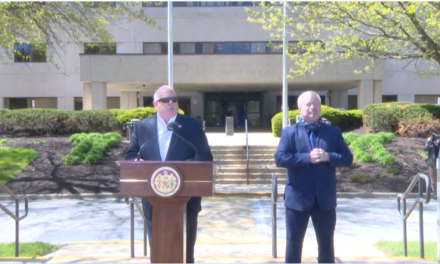By Steve Kilar
Capital News Service

The plaster cast at the Maryland Institute College of Art is a copy of the Parthenon’s Dionysus sculpture. It is owned by the state of Maryland but was restored by MICA.
Part of Dionysus’ plaster forearm had gone missing. Decades of public exposure had made this reclining male nude, a copy of a relic from the Parthenon in Athens, subject to wear.
“Just serendipitously, folks in the exhibitions department found it in a milk crate in some storage room, so the restorers were able to reconstruct it,” said Joseph J. Basile, an art history professor at Maryland Institute College of Art in Baltimore, home to more than a dozen sculptures from the state of Maryland’s artistic property collection.
But some of the old plaster figures at MICA, all replicas of well-known ancient sculptures, have not been as lucky. For instance, the Venus de Milo is missing her head and, barring another storeroom discovery, it will be costly to recreate, said Basile, an expert on classical sculpture who has studied the history of Maryland’s plaster casts.
Maryland’s tight budget has prevented proper care of many items in the state art collection. But the Maryland Commission on Artistic Property, which manages the collection for the Maryland State Archives, has been resourceful in its efforts to care for its holdings.
The State Archives has not neglected its assets, said Flora Arabo, a budget analyst who examined the archives’ funding for the 2012 fiscal year for the Maryland General Assembly. The agency simply has not been allocated enough money to do what the law requires, storing and protecting the state’s records, Arabo said.
Inadequate funding to maintain collection
“We have not ever gotten adequate funding for the maintenance side of dealing with the collection,” said Edward Papenfuse, the head of the archives. “A painting is in many ways almost a living and breathing object. It means that you have to be concerned about the aging of the paint; you have to be concerned about the aging of the canvas. It’s not dissimilar to being concerned about the upkeep and maintenance on a building.”
For the last few years, no money has been set aside in the budget for conservation of the art collection, said Alexander “Sasha” Lourie, the state’s art curator. The fiscal 2012 budget, approved by the legislature earlier this month, continues this trend.
Delegate Gail Bates, R-Howard, who sits on the subcommittee that oversees the budget for the State Archives, said that the agency is “valid and worthy of funding” but that the state is already spending too much.
“Mr. Papenfuse does a really fine job of reminding us of the importance of our records,” said Bates. “The budget’s always a challenge. I would have liked to have seen further cuts, but not necessarily in the Archives.”

This painting titled "Washington, Lafayette and Tilghman at Yorktown" by Charles Willson Peale has hung in the State House since 1784 and is likely worth over $20 million.
Maryland owns more than 3,000 works of art — paintings, drawings, sculptures and decorative items — that, collectively, are worth tens of millions of dollars.
It’s hard to quantify the value of the entire collection, said Lourie, but just one of the collection’s paintings — a scene by Charles Willson Peale from the end of the Revolutionary War, titled “Washington, Lafayette and Tilghman at Yorktown,” that has hung in the State House since 1784 — is likely worth well over $20 million.
Art works can’t be sold
Although the state’s art collection is classified for accounting purposes like state-owned land or a government office building, a legal exception prevents it from being sold in order to create revenue for the state, said Lisa Lester, a spokeswoman for the Maryland comptroller’s office.
“This protects the collection,” Lester said.
Although the state’s collection is protected from the auction block, it is not safe from natural degradation — exposure to moisture, light and temperature fluctuations — that affects all fine art.
Less than 40 percent of the state’s art collection is in good condition, according to a legislative analysis from last year. That means that about 60 percent of the state’s art holdings are in fair or poor condition.
“If you have things that are not in good condition, their condition will not improve,” said Lourie, the curator. “It will stay the same or it will get worse.”
If a piece of art is stored in an environment that is not ideal — and some of the storage facilities that the State Archives uses for its artworks are not — then the likelihood increases that a piece’s quality will decline, Lourie said. During a few years in the 2000s, the overall percentage of artwork in good condition actually dropped, according to legislative analyses.
The high cost of renting specialized art storage facilities has led the state to move many items into cheaper warehouse space that is not controlled for temperature and humidity. A budget form submitted to the legislature this year says, “Visible mold growth has been documented on several pieces of furniture and continued exposure to inappropriate environmental conditions will cause additional mold growth, flaking paint, corroding surfaces, failing mattes, losses of ornament on gilt frames and embrittlement of all objects.”
In addition, “security at the rented warehouses is nonexistent,” and these spaces have been both on fire and broken into within the last year, according to this year’s budget papers.
Half of art collection maintained by others
About half of the Maryland art collection is not in the state’s possession and even pieces kept by museums, such as the Baltimore Museum of Art and the Peabody Institute, are threatened. Economic problems have plagued museums in recent years and they can no longer afford to warehouse items from the state’s collection rent-free. But the state’s own facilities do not have space for these items and the “very modest amount of money that had been budgeted in the past for rent has been completely eliminated,” according to the legislative budget submission.
Even so, the art collection’s most pressing issue is not storage; it is the lack of money to conserve the art properly, said Papenfuse.
“There are elements in the collection, unfortunately, that just simply have not gotten the support that they deserve with regard to their ongoing conservation,” Papenfuse said. Although the nonprofit Friends of the Maryland State Archives can collect donations for conservation work, raising private funds has proven difficult.
“This is a teaching collection,” said Papenfuse. “In terms of the art market, if you were to put out some of these items individually, you wouldn’t get very much for them. Yet, they deserve conservation and attention. It’s very easy to get private support for things that have a high visibility and, on their own, stand as unique objects within the collection. It’s very difficult to get maintenance support for those things which are just sort of a part of the teaching collection.”
Proposals to repair artwork
On several occasions over the last decade, the State Archives has proposed conservation plans to repair Maryland’s artwork to good condition.
“There are a lot of determining factors” in deciding what works are conserved, said William Lewin, a Baltimore-based restorer. “If something is going out for a show or if it is going to be hung for exhibition or if it’s going to be moved in some way, they have to have it conserved before it is moved or exhibited. It’s a curatorial call from the archives.”
Instead of relying on the legislature for money, the State Archives has begun leaning on outside organizations, like MICA, for conservation assistance. MICA, not Maryland taxpayers, is paying for the school’s ongoing restoration of the state’s plaster sculptures, including Dionysus.
“We still own the object, the state owns the object, but they’ve paid for all the conservation on it,” said Papenfuse. In addition, when the state lends out a piece of art for exhibition, the borrowing institution is required to foot the restoration bill.
“When one of the objects in the collection … is of interest for exhibit purposes, the entity that’s interested in exhibiting it has to assume responsibility for any conservation that needs to be done,” Papenfuse said.
Art loans made on condition of conservation

"Young Woman in Black (Portrait of Madame J)" by the American impressionist Mary Cassatt was conserved by a European museum so that it was safe to travel for exhibition across the Atlantic.
Loaning on the condition of conservation has worked successfully for the State Archives in many instances. For example, one of the state collection’s best-known paintings, “Young Woman in Black (Portrait of Madame J)” by the American impressionist Mary Cassatt, was conserved by a European museum so that it was safe to travel for exhibition across the Atlantic.
“For a number of the objects in the collection which have gone on loan … they have gotten the kind of conservation attention that they deserve without it affecting the pocketbook of the state,” said Papenfuse.
In 2009, the State Archives lent the Francis Blackwell Mayer painting “The Burning of the Peggy Stewart,” which depicts Annapolis’ version of the Boston Tea Party, to the Fowler Museum at UCLA for a four-month exhibition. The museum agreed to pay half of the painting’s restoration costs and, after the show, the painting returned to Maryland for prominent display in the State House.
“By sharing the costs of that with the Fowler Museum,” said Lourie, “it enabled us to get a painting conserved that will soon be featured in the Old House of Delegates Chamber.”






According the the statue’s base, it is actually Theseus, not Dionysus.
Change the law and sell the stuff. Tens or hundreds of millions of dollars worth of art that’s decomposing and they can’t afford to keep it maintained. The value is dropping. I’d rather have lower taxes than some picture that I’ll never see. Sure, it’s nice to have art. If we had unlimited money, fix it and keep it. But, that’s not the way things are. Sell it now or have a pile of worthless scrap later.